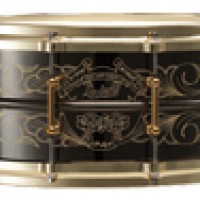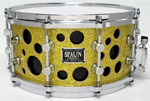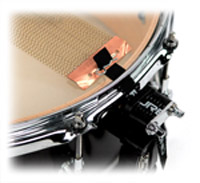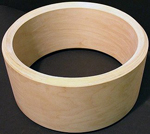
This piece of gear, more than any other in my humble opinion goes the furthest in creating your personal, signature sound. A classic example of this for me is Alex Van Halen. If you become familiar with his classic sound, you can tell instantly when it is him playing.
 The flip side to this is to try and find a snare drum that is perfect for any occasion. This is where addiction sets in and drummers begin to collect snares like comic books. If you have the budget (and storage space) for multiple snares, then go for it.
The flip side to this is to try and find a snare drum that is perfect for any occasion. This is where addiction sets in and drummers begin to collect snares like comic books. If you have the budget (and storage space) for multiple snares, then go for it.
Here are a few key factors when determining what snare is right for you…
Shell Material: Just like our previous discussion on tom and bass shells, this can be the greatest determining factor to the tone you will get out of your drum.
The difference with snare drums is that you don’t just have a choice of various woods, but also various metals. For more specifics on the affects of wood shells on your tone, check out the “Drum Shells” section of this article.
The main metals used in snare drum construction are steel, brass, aluminum, bronze, and copper. Here is a quick breakdown of each…
- Steel: Steel possesses lively high tones and very good projection. Steel is considered to be a very “bright” sounding metal. One characteristic of steel which sets it apart is its substantial sustain. This is best suited for heavy rock and funk applications.
- Brass: Brass has a broader tonal range than steel. It is also a much warmer sound yet still possesses quite a crack when needed. This makes brass ideal for the drummer who will be playing various styles of music. A great all around, versatile sound.
- Aluminum: This material is bright like steel. The main difference is it possesses a slightly warmer tone yet not as warm as brass. Aluminum shells have a slightly shorter sustain than steel. This results in a clean crisp crack.
- Bronze: Another slightly warmer sounding metal. Bronze produces a nice sound which cuts through decently but does not have the higher end tonal range. This results in much less of an obnoxious crack.
- Copper: Copper has a substantial low end tonal range. This metal tends to be very responsive. Copper tends to be limited in its applications and many drummers find they can cover the same ground by playing with the tuning of their brass snare drums.
Venting: Oh man… have we gone off the deep end here! It seems to be one of the latest trends in the world of snare drums to try and “one up” the other guy in finding new and unique ways to vent snare drums.
 Vents started off as the single little hole you see in the drum shell with some sort of grommet framing it to protect the shell. Now drum companies are putting multiple holes of varying sizes all over the snare shell.
Vents started off as the single little hole you see in the drum shell with some sort of grommet framing it to protect the shell. Now drum companies are putting multiple holes of varying sizes all over the snare shell.
 Some companies are even cutting the shell completely in half horizontally, putting a 1 or 2 inch gap between the top and bottom halves, and holding the whole thing together with the lug assemblies. Really?!?!?
Some companies are even cutting the shell completely in half horizontally, putting a 1 or 2 inch gap between the top and bottom halves, and holding the whole thing together with the lug assemblies. Really?!?!?
The main affect venting has on a snare is to reduce much of the shells natural sustain and resonance. The second byproduct of venting is an increase in volume.
This can be great if you are playing in a large venue and you want a distinct crack to cut through. However, this creates an extremely limited drum that in most venues will be extreme over kill and many sound guys as well as audience members will be calling for your head on a platter!
Shell Thickness: I touched on the parameters of shell thickness previously with regard to tom and bass drum shells. Many of the same principles apply here.
One of the main differences when talking about shell thickness in snare drums is when you are diving into the metal shells. These are not talked about in number of plies like the wood shells. Metal snare shell thickness is measured in millimeters.
Most snare commonly fall anywhere from 1.0mm to 3.0mm in thickness. Just like with the wood shells, thinner shells result in a lower pitch and the thicker shells produce a higher pitch.
With regard to snare drum wood thickness, just like venting we have gone off the deep end here as well. Most snares stick to the common 6, 8, or 10 ply shells. In recent years many companies have started to offer snare shells anywhere from 20 to 50 plies thick. WOW!
These shells are designed specifically for high tones and extremely high volume. If this is what you are looking for, than this is the way to go. Remember though, this is not the type of snare you will want to pull off a jazz gig.
 Snare Wires: The snare wires are the metal strands you see running across the bottom of a snare drum. This is what produces the “buzz” sound when the drum is hit. The general rule of thumb is; the more wires or thicker the band, the more “buzz” sound generated. Conversely, the less wires, the more drum shell tone you will hear.
Snare Wires: The snare wires are the metal strands you see running across the bottom of a snare drum. This is what produces the “buzz” sound when the drum is hit. The general rule of thumb is; the more wires or thicker the band, the more “buzz” sound generated. Conversely, the less wires, the more drum shell tone you will hear.
The common standard on today’s drums is a total count of 20 wires. You can get as few as 12, and as many as 50 wires depending on what sound you are going for. The snare wire sound can be controlled to a certain extent by adjusting the tension on the wires. I touch on this in the “Snare Tuning” video in the “Play Drums By Ear” course.
Sizes: Snare drum depths are broken up into 3 major categories: Piccolo, Standard, and Deep.
- Piccolo- 3” – 4.5” deep
- Standard- 5” – 5.5” deep
- Deep- 6”- 10” deep
The shallower the shell depth, the higher pitch the drum will produce.
Snare drums are also categorized by the diameter as well.
- Popcorn- 10” diameter
- Soprano- 12” and 13” diameter
- Standard- 14” diameter.
These sizes, in tandem with the depth of the shell drastically change the tone of your drum. Once again, smaller equals a higher pitch than a larger diameter shell.

Leave A Reply (No comments so far)
No comments yet